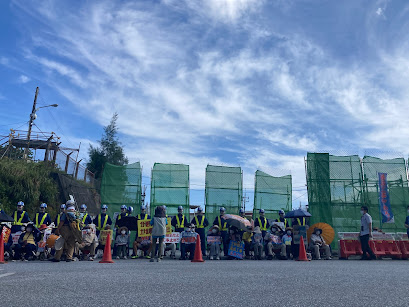Police House Raid on an Entomologist and World Heritage Inscription of Yambaru Forest 警察による蝶研究者の家宅捜査、そしてやんばるの森の世界遺産登録
 |
| "SOS" written with discarded military materials in the Yambaru Forest Image Source: Akino Miyagi's Facebook |
We hope that the media take every step to find out who was behind the police action and reveal and tell the whole story.
Sadly though, the Okinawa Prefectural Government and the Environment Ministry have remained silent so far for whatever reasons.
This incident is a reminder of the complex relationship in motion between the militarized reality of Okinawa, its resilient natural Environment, the colonializing and colonized attitudes of the central and local governments, and those who fight for the protection of the Environment and refuse the further militarization of the islands. It deserves more critical attention at the domestic and international levels.
Many people have questioned whether the police house raid on Akino-san is somehow connected to the fact that the Yambaru forest, along with Amami-Oshima, Tokunoshima, and Iriotomote, will be examined for UNESCO World Heritage (WH) inscription at the UNESCO World Heritage (WH) Committee meeting in China next month. Some have also wondered whether this could bring about unwanted consequences. While these are understandable questions, it is just hard to find any answers to them at this point.
The World Heritage Programme of the International Union for Conservation of Nature (IUCN) has recommended that the UNESCO WH Committee inscribe them as WH sties. IUCN's current recommendations came three years after IUCN "deferred" the Japanese Ministry of the Environment's first inscription attempt in June 2018. The Environment Ministry revised and submitted its second application to IUCN in January 2019. The various issues of the Northern Training Area (NTA), hardly mentioned in its first application, were addressed in its second application.
However, the IUCN World Heritage Programme's Evaluations released on June 4 mention the issue of the Yambaru forest and the NTA simply as follows.
"However, there is an anomaly in the configuration of the Okinawa component part of the nominated property, with a long strip of the JWTC (or NTA) protruding into the nominated property, but not included in it." (p. 7-8)
There is no mention of how the discarded military materials should be disposed of and how the impacts of military training on the Environment should be reduced and monitored. This is despite that local residents and NGOs had requested the IUCN WH Programme to address these critical issues in its Evaluations and Recommendations.
We need to seek explanations from both the IUCN WH Programme and the Environment Ministry why there was no mention of these issues in the Evaluations and Recommendations and how they discussed them and what outcomes such discussion had produced and in what form. After reviewing their explanations, OEJP will decide what action to take next.
For the Yambaru forest to be a UNESCO World Heritage site, the forest needs more people like Akino-san, who can tell the values of the forest, inform the public and the IUCN and UNESCO of the actual condition of the Yambaru forest, and fight for its protection.
The Okinawa civil society has the responsibility to work with IUCN and UNESCO to counteract and complement the shortcomings of the Japanese government, the Okinawa prefectural government, and the U.S. military to keep the Yambaru forest worthy of being a WH site.
A World Natural Heritage without military training and facilities: that's what the Yambaru forest should aim for.
今回の蝶研究者宮城秋乃さんへの警察による家宅捜査は、本当に酷く、許されるものではない。明らかな警察による威嚇であり人権侵害だ。秋乃さんが無事で、警察に屈せず、また市民社会がすぐに抗議声明を出せたことはなによりであった。
誰がこの警察の動きの背後にいるのか、なぜこのようなことが起こったのか。メディアには徹底追求して欲しい。しかし沖縄県と環境省から何もないのは非常に残念である。
 |
| 米軍の廃棄物で書かれたやんばるの森からのSOS Image Source: 宮城秋乃Facebook |
軍事化された沖縄、それでもそこに残る素晴らしい自然。沖縄を植民地のように扱う日本政府とそれにきちんと抵抗できない沖縄県、それでもこの島の自然を守り更なる軍事化に反対する人々。この複雑な関係に国内外から目が向けられることを期待したい。
今回秋乃さんが受けた家宅捜査と、やんばるの森(沖縄本島北部)、奄美大島、徳之島、西表島の世界自然遺産登録が審議される7月のユネスコユネスコ世界自然遺産委員会は何か関係があるのかと疑問を持っている人はいるはずだ。またこれらの候補地の登録について悪影響がでるのではないかと考る人もいる。これらの疑問は当然といえるが、答えは見えてこない。
世界遺産の動きについて幾つか確認しておこう。まず去る5月に国際自然保護連合(IUCN)の世界遺産プログラムがユネスコ世界遺産委員会に対して、4つの候補地を世界自然遺産として登録するよう勧告した。IUCNが環境省と行ってきたこの3年間の調整を踏まえての結論だ。
2017年1月に環境省が最初の推薦書をIUCNに提出した。それに対して2018年6月にIUCNは登録延期を勧告。飛び地の問題や北部訓練の問題等がその理由だった。その後、環境省は推薦書を大幅に修正し2019年1月に再提出。最初の推薦書では殆ど触れなかった北部訓練場についても多くが記載された。
そして去る6月4日にIUCNの公式の評価・勧告書が公表された。しかし北部訓練場の問題については以下の表現にとどまっている。
"However, there is an anomaly in the configuration of the Okinawa component part of the nominated property, with a long strip of the JWTC (or NTA) protruding into the nominated property, but not included in it." (p.7-8)
「米軍のジャングルトレーニングセンターの細長い一帯が沖縄本当北部の推薦地に入り込んでいるが、推薦地には含まれておらず、推薦地の形状において変則的な(異常な)存在となっている」(p.7-8)
米軍の廃棄物をどのように除去すべきか、また米軍の訓練をどのように減少させるか、モニタリングするべきかなどの重要な問題については触れられていない。これらの問題は、環境省の2回目の推薦書を踏まえて、地域住民とOEJPを含む環境NGOが指摘し、IUCNにその評価・勧告書で言及するように要求していたものだ。
なぜ公式の評価・勧告書でこれらの問題が記載されいないのか。IUCNがどのように日本政府に問題提起をしたのか、日本政府はどのように対応したのか。OEJPとしても、まずIUCNや環境省に説明を求め、次のアクションを起こしていく予定だ。
今回の秋乃さんの件と世界遺産登録に関するOEJPのスタンスは以下の通りである。
やんばるの森を世界自然遺産にするには、宮城秋乃さんのように、やんばるの森の自然の価値をよく知り、その実態を隠すことなくきちんと広く伝え、森の保護のために取り組める人がもっと必要である。
やんばるの森を世界自然遺産にするには、沖縄の市民社会は、IUCNや国際機関/団体と連携し、日本政府、沖縄県そして米軍の取り組みの問題点を指摘し、対応させる責任を担う。
軍事訓練や軍事施設のない世界自然遺産。それがやんばるの森のあるべき姿である。


